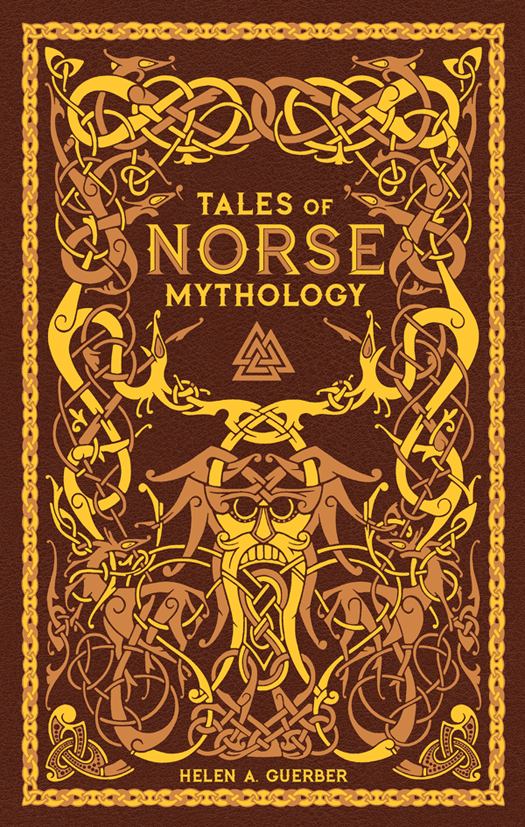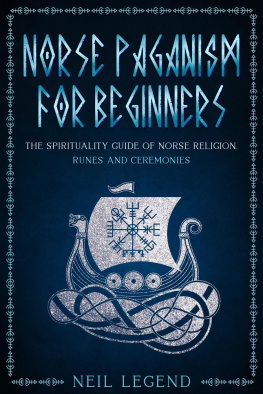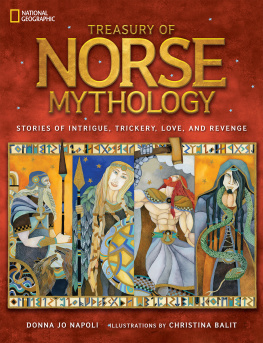Hélène Adeline Guerber - Tales of Norse Mythology
Here you can read online Hélène Adeline Guerber - Tales of Norse Mythology full text of the book (entire story) in english for free. Download pdf and epub, get meaning, cover and reviews about this ebook. City: New York, year: 2017, publisher: Barnes & Noble, genre: Art. Description of the work, (preface) as well as reviews are available. Best literature library LitArk.com created for fans of good reading and offers a wide selection of genres:
Romance novel
Science fiction
Adventure
Detective
Science
History
Home and family
Prose
Art
Politics
Computer
Non-fiction
Religion
Business
Children
Humor
Choose a favorite category and find really read worthwhile books. Enjoy immersion in the world of imagination, feel the emotions of the characters or learn something new for yourself, make an fascinating discovery.

- Book:Tales of Norse Mythology
- Author:
- Publisher:Barnes & Noble
- Genre:
- Year:2017
- City:New York
- Rating:3 / 5
- Favourites:Add to favourites
- Your mark:
- 60
- 1
- 2
- 3
- 4
- 5
Tales of Norse Mythology: summary, description and annotation
We offer to read an annotation, description, summary or preface (depends on what the author of the book "Tales of Norse Mythology" wrote himself). If you haven't found the necessary information about the book — write in the comments, we will try to find it.
Tales of Norse Mythology — read online for free the complete book (whole text) full work
Below is the text of the book, divided by pages. System saving the place of the last page read, allows you to conveniently read the book "Tales of Norse Mythology" online for free, without having to search again every time where you left off. Put a bookmark, and you can go to the page where you finished reading at any time.
Font size:
Interval:
Bookmark:

NORSE
MYTHOLOGY

HELEN A. GUERBER

Introduction 2006 by Sterling Publishing Co., Inc.
Cover illustration 2017 by Sterling Publishing Co., Inc.
All rights reserved. No part of this publication may be reproduced, stored in a retrieval system, or transmitted in any form or by any means (including electronic, mechanical, photocopying, recording, or otherwise) without prior written permission from the publisher.
This 2017 edition printed for Barnes & Noble by Sterling Publishing Co., Inc.
Originally published in 1909 as Myths of the Norsemen from the Eddas and Sagas
ISBN 978-1-4351-6499-4
Barnes & Noble, Inc.
122 Fifth Avenue
New York, NY 10011
www.sterlingpublishing.com
Cover design by Freki Wodenswolf Jungnickel
Endpaper art Ragnarok by Johannes Gehrts (18551921), courtesy of Wikimedia Commons
Kirsten Wolf
Every culture throughout history has tried to find answers to the mysteries of life: how the world began and what was there before then, what the limits of the world are and how they were established, how humans were created and where they go when they die, and how the world will come to an end and what will happen after that. The Viking Age Scandinavians answered these questions in their myths and legends which personified the forces of order and chaos through the continuous struggle between gods and giants. Folklorist Helene Adeline Guerber brings to life these stories in Myths of the Norsemen from the Eddas and Sagas. Ranging from the comic to the tragic, the myths and legends tell of passion, love, friendship, pride, courage, and betrayal. Among the characters we meet are giants who fight the gods and yet are not entirely evil; norns who determine the course of an individuals destiny; dwarves who live in rocks and work as craftsmen; tutelary goddesses who are associated with fertility and death; valkyries who select and gather dead warriors from the battlefield; female fetches who attach themselves to individuals at birth and remain with them till death; elves who promote fertility and are associated with deceased kinsmen; divine heroes of Norse or continental Germanic origin; animals, birds, and monsters. They inhabit various worlds: Asgard, the residence of gods, goddesses, and fallen warriors; Utgard, where giants and monsters live; Midgard, the home of humans; and Nifl-heim, the sinister abode of the dead. A subject of intense study by some of the Western worlds greatest scholars of myth, religion, and folklore, Norse mythology is also a source of inspiration for many literary, pictorial, and musical artists. German composer Richard Wagner, for example, popularized Norse mythology with his operatic cycle Der Ring des Nibelungen.
Helene Adeline Guerber was born in Mount Clemens, Michigan, in 1859. With the exception of her education, for which she went to Paris, France, she lived most of her adult life in New Jersey, where she died in Montclair in 1929. A teacher by profession, Guerber devoted her life to educating her fellow citizens about European literary and cultural history through the publication of about three dozen books on a vast array of topics ranging from famous operas to Jewish history to Shakespeares plays. Myths of the Norsemen from the Eddas and Sagas, originally published in 1895 under the title Myths of Northern Lands, was her second book.
Scholarly preoccupation with Scandinavian mythology goes back to the sixteenth century, but became especially intense during the Romantic period when the Nordic countries began to reflect more on their past histories. As such, Myths of the Norsemen from the Eddas and Sagas is and was but one of many studies, and while it did not contribute to scholarship within the field of Scandinavian mythology, it did much to make the Norse myths and legends known in the English-speaking world and now has the status of a classic. In twenty-nine chapters, Guerber retells and explains the age-old Norse stories about the beginning of the world and its end, and about gods, goddesses, giants, dwarfs, elves, and heroes of Germanic folklore. The book concludes with a comparison of Norse and Greek mythology, on which she had published a book in 1893. The poetic quotations from sagas and poems interspersed throughout this volume give readers a feel for how the myths and legends may have been told originally, and the large number of illustrations showing gods and goddesses engaged in heroic deeds help visualize the stories related. An extensive glossary and index make the book a useful reference tool.
The Norse myths and legends are among the most fascinating tales of all times. Most of them are dramatic narratives detailing episodes in a slowly evolving story that begins with the frost-giant Ymir, who owed his existence to the coming together of heat and frost in the gaping void of Ginnungagap. Ymir was sustained by the primeval cow Audhumla, who fed off the ice itself, licking the salty blocks. By the end of the first day, there appeared from the blocks a mans hair, by the end of the second day a mans head, and by the end of the third day the whole man. The man became the ancestor of the first gods, Odin and his brothers Vili and Ve. The three killed Ymir and brought him into the middle of Ginnungagap. From his flesh they made the earth, from his bones the mountains, and from his teeth and shattered bones pebbles and small rocks. His blood became lakes and the sea, which encompassed the earth on all sides, and his skull became the sky. This world was protected from the giants by a wall made from the eyebrows of Ymir and was called Midgard, the home of humans, whom the gods created from two tree trunks on the shore and endowed with breath, wit, hearing, vision, and other qualities of life.
While some of the myths and legends are deeply tragic, others are extraordinarily humorous. Famous among the former is the sad tale of the death of Odins son, the innocent and handsome Baldr, who is so troubled by disturbing dreams of his own demise that his mother, the goddess Frigg, extracts solemn vows from all beings, animate and inanimate, that nothing will harm him. But she neglects to ask a mistletoe, which, through the machinations of the mischievous demi-god Loki, is transformed into a murderous weapon and brings about the death of the beloved god. To the latter category belongs the lighthearted tale of the giant Thryms theft of the precious hammer of the warrior god Thor, and his refusal to return it, unless Freyja, the goddess of fertility and sexual love, is given to him as his bride. Without the hammer the gods are helpless against the giants, and so Thor, the epitome of masculinity, reluctantly undertakes a journey to the land of the giants, decked out in bridal regalia and posing as Freyja with Loki as his handmaid. Surprisingly, Thrym and the other giants are taken in, and when Thrym orders up the precious hammer to bless the bride with, Thor uses the opportunity to batter all the giants.
The story about Thors stolen hammer is usually cited for its entertainment value, but it is also instructive in that it stresses the two most common themes in the myths: on the one hand, the sexual attraction between gods and giants, and on the other, the hostility between them. The hostility between the inhabitants of Asgard, the home of the gods, and Utgard, the land of the giants, is typically presented as struggles between individual gods and giants, and most of them involve Odin and his son Thor. However, the two major gods stand in sharp contrast to one another, and in their combats with the giants they use very different means. The complex Odin usually uses strategy, that is, cunning and wit. Odins immense wisdom had in large measure to do with the sacrifice of his one eye for a drink from the well of the god Mimir, in which all wisdom was stored, and his mastery of poetry, which he had stolen from the giants and given to gods and humansthe topics of yet other myths. The simpleminded Thor, by contrast, uses force, symbolized by his hammer. The story of Thors struggle during a fishing trip against his most formidable enemy, the world-encircling serpent Iormungand, who lives in the ocean, fascinated not only medieval writers and poets, but also pictorial artists. Two major versions of the myth exist; their main point of difference is that in one Thor conquers this symbol of evil, while in the other he fails to do so.
Font size:
Interval:
Bookmark:
Similar books «Tales of Norse Mythology»
Look at similar books to Tales of Norse Mythology. We have selected literature similar in name and meaning in the hope of providing readers with more options to find new, interesting, not yet read works.
Discussion, reviews of the book Tales of Norse Mythology and just readers' own opinions. Leave your comments, write what you think about the work, its meaning or the main characters. Specify what exactly you liked and what you didn't like, and why you think so.





